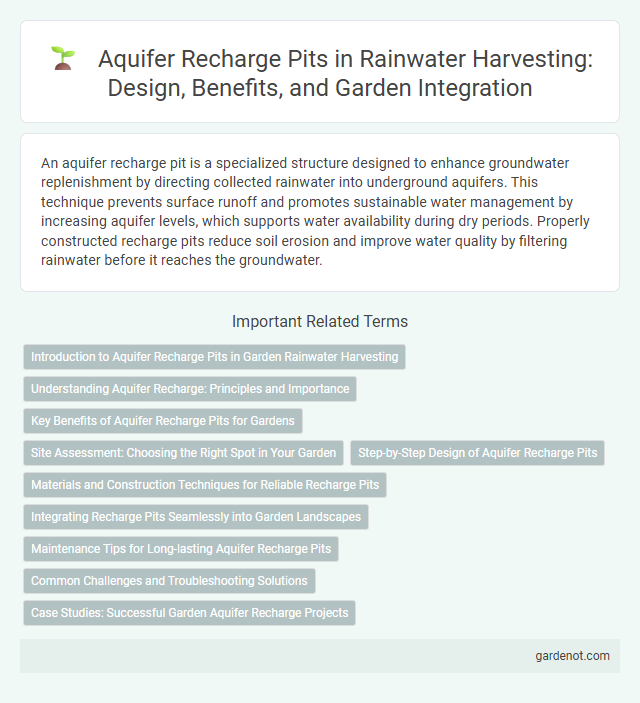An aquifer recharge pit is a specialized structure designed to enhance groundwater replenishment by directing collected rainwater into underground aquifers. This technique prevents surface runoff and promotes sustainable water management by increasing aquifer levels, which supports water availability during dry periods. Properly constructed recharge pits reduce soil erosion and improve water quality by filtering rainwater before it reaches the groundwater.
Introduction to Aquifer Recharge Pits in Garden Rainwater Harvesting
Aquifer recharge pits are designed structures that capture and infiltrate rainwater directly into underground aquifers, enhancing groundwater levels in garden rainwater harvesting systems. These pits typically consist of vertical shafts filled with permeable materials like gravel and sand, allowing efficient percolation of collected rainwater. By replenishing local aquifers, aquifer recharge pits support sustainable water management and reduce dependency on external water sources for garden irrigation.
Understanding Aquifer Recharge: Principles and Importance
An aquifer recharge pit is a critical structure designed to enhance groundwater replenishment by capturing surface runoff and allowing it to percolate into underground aquifers. Understanding aquifer recharge involves recognizing the natural process of water infiltration that restores groundwater levels, which is essential for sustaining water supply during dry seasons and mitigating water scarcity. This technique supports ecological balance and improves groundwater quality by filtering pollutants through soil layers before reaching the aquifer.
Key Benefits of Aquifer Recharge Pits for Gardens
Aquifer recharge pits enhance garden health by increasing groundwater levels, ensuring a sustainable water source for irrigation during dry periods. These structures reduce soil erosion and improve soil moisture retention, promoting robust plant growth. By filtering rainwater naturally, aquifer recharge pits also minimize pollutants, contributing to a cleaner and healthier garden ecosystem.
Site Assessment: Choosing the Right Spot in Your Garden
Site assessment for an aquifer recharge pit involves analyzing soil permeability, groundwater table depth, and proximity to contamination sources to ensure efficient water infiltration and safety. Ideal locations have well-draining soils, a minimum distance of 10 meters from septic tanks or chemical storage, and sit above permeable strata to facilitate recharge. Proper assessment maximizes rainwater recharge, reduces runoff, and protects groundwater quality in your garden.
Step-by-Step Design of Aquifer Recharge Pits
Aquifer recharge pits are designed by first assessing the soil permeability and groundwater table depth to ensure efficient infiltration. Next, selecting an appropriate pit size--commonly 1 to 3 meters in diameter and 2 to 4 meters deep--maximizes water storage while preventing clogging through gravel or sand filtration layers. Final steps include incorporating inlet channels to direct rainwater runoff into the pit and covering the pit with a perforated lid to prevent debris entry while allowing water passage.
Materials and Construction Techniques for Reliable Recharge Pits
Aquifer recharge pits are constructed using permeable materials like gravel, sand, and coarse soil layers to enhance water infiltration and prevent clogging. Lining these pits with geotextile fabric improves filtration while maintaining permeability and structural integrity. Proper excavation, compaction, and layering techniques ensure durability and optimize recharge efficiency in diverse geological conditions.
Integrating Recharge Pits Seamlessly into Garden Landscapes
Aquifer recharge pits can be integrated seamlessly into garden landscapes by designing them as aesthetically pleasing water features that blend with existing plants and pathways. Using native vegetation around the pits enhances filtration while maintaining natural beauty and promoting biodiversity. Proper placement and sizing ensure efficient groundwater replenishment without disrupting garden functionality or visual harmony.
Maintenance Tips for Long-lasting Aquifer Recharge Pits
Regular inspection and removal of silt, debris, and organic matter ensure optimal functioning of aquifer recharge pits. Maintaining clear inlet and outlet channels prevents clogging and promotes efficient groundwater infiltration. Periodic desilting and repairing structural damages extend the lifespan and effectiveness of recharge pits in sustaining groundwater levels.
Common Challenges and Troubleshooting Solutions
Aquifer recharge pits often face challenges such as clogging due to silt accumulation, improper site selection leading to ineffective water percolation, and contamination from surface runoff. Regular maintenance involving sediment removal and installation of pre-filtration systems can mitigate clogging issues. Selecting appropriate locations with permeable soil and implementing protective measures against pollutants ensure efficient and safe aquifer recharge.
Case Studies: Successful Garden Aquifer Recharge Projects
Case studies of garden aquifer recharge projects demonstrate significant improvements in groundwater levels and soil moisture retention through the use of aquifer recharge pits. In regions like Rajasthan, India, these pits have effectively captured monsoon runoff, reducing water scarcity during dry seasons and enabling sustainable urban gardening. Data from projects in Bangalore reveal a 30% increase in groundwater recharge, showcasing the pits' role in enhancing local water security and promoting eco-friendly landscaping.
Aquifer recharge pit Infographic

 gardenot.com
gardenot.com